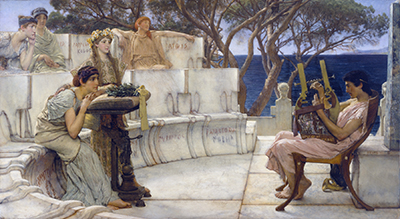Lawrence Alma-Tadema made the oil painting of Sappho and Alcaeus. As a painter of classical themes, we know him to represent the luxury and decline of the Roman Empire, placed in a magnificent marble on the dazzling Mediterranean blue sky and sea background.
Although he had rented his ship and his classic antique representations throughout his life, his work after his death was in disrepute. It was about nineteenth century British art that its importance was reassessed. They keep the paintings of Sappho and Alcaeus at the Walters Art Museum in Baltimore. The size of this painting is 66 x 122 cm. It shows a concert in the second half of the 7th century BC, and Mytilene’s poet Alcaeus, played the kithara. The satirical lesbian poet Sappho is part of the public. Sappho gives special attention to performance and puts her arm on the laurel carpet with a laurel wreath. The painting shows the passage recorded by the poet Hermesianax in the Déipnosophistes d’Atipée.
The oil painting techniques used to make Sappho and Alcaeus are mixed colour pigments and oily supports. He used traditional wooden pallets to mix a small amount of paint during work. Because of his deep interest, the artist’s style offsets the transmission of fundamental human qualities, including intellectuals and emotional audiences. He draws attention to Sapho and Alcaeus with a neutral background and clear details. The white marble seats lined up in a row inspired by the Dionysos Theater in Athens, but Alma-Tadema replaced the original name of the seal of Athens with the names of friends of Sappho. In the background, you can see the Aegean Sea through several trees.
The exhibition of the painting was at the Royal College of Art in 1881 and was drawn to the private view of William Powell Fries on the far right of the Royal College of Art in 1881, under the control of John Everett Millais. Critics appreciate him: they say he is “exciting”. William Thompson Walters of Baltimore and his son gained it, Henry Walters inherited it in 1894 and bequeathed it to the Walters Art Museum in 1931 (Walters Art Museum).




